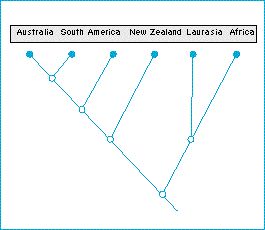Evolutionary biogeography - How has continental drift affected geographical distribution?

Area cladograms
Brundin reconstructed the phylogeny of these midges using standard morphological techniques and then used the speciesí modern biogeographic distributions to draw a combined picture of their phylogeny and biogeography, called an area cladogram.
If the successive splits in the phylogeny were driven by successive break-ups of the land, the phylogeny implies a definable sequence of tectonic events, something like this. To begin with, the common ancestor of the modern forms would have occupied a large area made up of all their modern distributional zones - which implies the existence, sometime in the past, of a southern supercontinent, Gondwanaland. Gondwanaland would then, Brundin's analysis predicts, have split in the following order:
• South Africa splits from a combination of Australia, New Zealand, and South America;
• then New Zealand splits from South America and Australia;
• and finally Australia splits from South America.
This prediction can be tested against the geological evidence, which was only accumulating during and after Brundin's work: and the geology turned out to fit Brundin's prediction.
Figure: area cladogram of chironomids. The diagram shows the phylogenetic relationships between the midges from different areas.
| Next |



